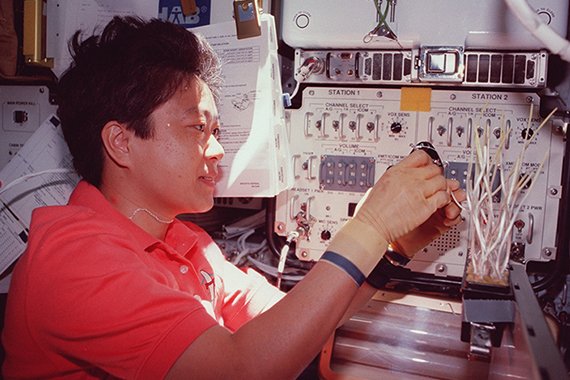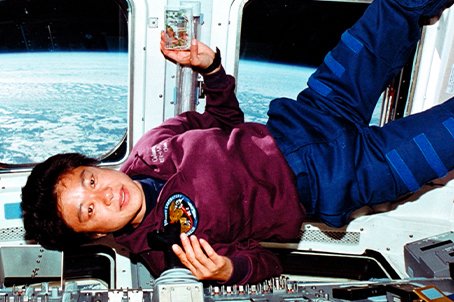MUKAI Chiaki
M.D., Ph.D. in Medical Science
Former JAXA astronaut
Technical Counselor
First female Asian astronaut to fly in space, twice boarding the Space Shuttle

Profile

MUKAI Chiaki Today
Senior Advisor to the Executive Director of JAXA.
Vice President of the Tokyo University of Science.
Missions
-
 Planning (in 1994) of Second International Microgravity Laboratory (IML-2/STS-65)
Planning (in 1994) of Second International Microgravity Laboratory (IML-2/STS-65) -
 STS-95 mission (1998)
STS-95 mission (1998)
JAXA Digital Archives
Background
MUKAI Chiaki was born in 1952 in Tatebayashi City, Gunma. She was selected as an astronaut in 1985, and in 1994 became the first Asian astronaut to board the Space Shuttle Columbia. While onboard, she carried out experiments related to the life sciences and space medicine. In 1998, she joined NASA’s John Glenn and others on an experimental mission as a Payload Specialist.

Chiaki
Born in Tatebayashi, Gunma, Japan.
Graduated from Keio University School of Medicine and received license to practice medicine. In 1988, received Doctorate in Physiology, also from Keio University.
Worked as a resident in General Surgery at the Keio University Hospital.
Selected alongside Mamoru Mohri and Takao Doi by the National Space Development Agency of Japan (NASDA, currently Japan Aerospace Exploration Agency) as a Payload Specialist for NASA’s First Material Processing Test (FMPT)/STS-47 mission.
Became a visiting scientist of the Division of Cardiovascular Physiology, Space Biomedical Research Institute, NASA Johnson Space Center.
During the First Material Processing Test (FMPT)/STS-47 mission, served as ground-based communicator for crew science operations.
From this year, worked as a research instructor in the Department of Surgery, Baylor College of Houston, as well as serving as a visiting professor of the Department of Surgery, Keio University school of Medicine until 1998.
Flew on the Space Shuttle Columbia as a Payload Specialist for the International Microgravity Laboratory (IML-2) mission STS-65.
Conducted 82 life science (human physiology, space biology, radiation biology and bioprocess) and microgravity science (material and fluid science, research on microgravity environment and countermeasures) experiments.

Served as a Spacelab communicator for crew science operations as a backup Payload Specialist for the STS-90 (Neurolab) mission.
Flew on the STS-95 mission as a Payload Specialist along with US Senator John Glenn, the first American astronaut to orbit the Earth. During the mission, conducted various life science and space medicine experiments.

Assigned as deputy mission scientist for the STS-107 mission.
Coordinated research operations in materials science, life science, and space medicine experiments for the STS-107 mission.
Worked as a visiting professor at the International Space University (ISU), with the goal of contributing to research into space medicine and health management on the International Space Station (ISS) for ISU Master Program students.
Appointed as Director of the Space Biomedical Research Office, Human Space Technology and Astronaut Department, Human Space System and Utilization Mission Directorate of the Japan Aerospace Exploration Agency (JAXA).
Became Senior Advisor to the Executive Director of JAXA.
Appointed as Director of the JAXA Center for Applied Space Medicine and Human Research (J-CASMHR).
Appointed to the Ministry of Education, Culture, Sports, Science and Technology (MEXT) International Space Exploration Subcommittee.
Became JAXA Technical Counselor. Also appointed as Vice President of the Tokyo University of Science.
Unless specified otherwise, rights to all images belong to ©JAXA






